 PREVIOUS
NEWS
PREVIOUS
NEWS
Tuesday, September 20, 2016
Belleek Newslettre (# 20.1)
** 160th BELLEEK POTTERY
ANNIVERSARY GATHERING !!
TENTATIVE : Ms. Johannah Purdon, our faithful
event organizer, is
considering a Belleeker Gathering
at the Belleek Pottery in Ireland
this coming
Spring Time !!
We are looking at the last two weekends in April.
Patricia has to talk
to the hotel there. It will be
the one we were at for the 150th
Anniversary !!
AGAIN, this is QUITE tentative at this time, BUT
you SHOULD contact
Johannah if you believe you’d
possibly like to attend so she can begin
to solidify
arrangements for our Gathering !! NO additional
details are
known at press time, but you may
contact Johannah as follows :
E-mail : gracie@AlwaysLuv2Shop.com
Télè : 201-314-8072
You may also wish to obtain Gathering Updates
directly from my Upcoming
Events Site at :
Belleek
Events !!
I’ll be posting Updated information promptly as I
Receive it !!
I can't stress this more !! It's VERY
important to contact Johannah
ASAP
if you plan on
attending OR even ‘believe’ you MAY attend !!
AND, as ALWAYS, PLEASE pass this on, i.e.,
[FORWARD] to ALL your
Belleeker friends and
acquaintances !!
**
IF IT WORKS !!
Did you ever have someone switch your cereal with
dog food as a joke ??
Then you realize it after about two months and
you start buying dog
food instead of cereal for
breakfast because your hair grows in thicker
and
it's shinier and your teeth don't have tartar on
them .. ..
Me neither, a couple of times !!
Hey, it makes things easy because I like to buy
in bulk !!
**
VICTORIAN ERA ORIGINS !!
The town of Belleek was founded in 1610 by two
brothers, Edward and
Thomas Blennerhassett,
from Norfolk, England, who had been granted
farming estates in County Fermanagh along the
River Erne. The town took
its name from a large
flagstone, known as Beal Leice in Gaelic, at the
foot
of a waterfall. The flagstone had been a prominent
river crossing
point for some centuries. The location
next to the river also provided
a powerful source of
energy for operating water powered mills. The
Blennerhassett family built a castle in Belleek,
originally called
Hassett's Fort.
Sir James Caldwell purchased the Blennerhassett
estate, which
encompassed the town of Belleek and
its castle, changing its name to
Castle Caldwell.
Over time, however, the castle and the estate fell
into disrepair. It was only with the arrival of John
Caldwell,
returning from military service in the
Americas to take over the family
estate, that
Castle Caldwell was restored. Caldwell passed the
estate
on to his daughter, who married John
Bloomfield and produced a son,
John Caldwell
Bloomfield.
Born in 1823, the younger John (Caldwell) Bloomfield
inherited the
family estate in 1849, at a time when
the surrounding population was
still reeling from the
devastation of the Potato Famine. As owner of
Belleek and its surrounding areas, he sought ways to
provide employment
for his tenants and alleviate
their poverty.
Bloomfield commissioned a geological survey of the
region and
discovered large clay deposits, as well
as kaolin, flint, feldspar, and
shale. He quickly
organized a business around the deposits,
establishing a mill on a small island in the
River Erne from which to
grind the clay and
raw materials for making slip, a liquid potter's
clay.
By 1853, the quality of the Belleek slip provided the
basis for
an award winning dinner service produced
by the Worcester Porcelain
Company for the Dublin
International Exhibition.
With all the ingredients needed to fashion crockery,
Bloomfield decided
to build a pottery workshop at
Belleek as well. For this, he enlisted
the aid of
architect Robert Williams Armstrong, who had built
up a
specialty designing potteries in the British
Midlands and who had been
working for Worcester
in the early 1850s. Armstrong agreed to design
the
pottery and lead development of the works. The
pair then found a
financial backer in David McBirney,
a prominent businessman from
Dalkey, near Dublin.
In exchange for McBirney's investment, the company
became known as D. McBirney & Co.
Construction began on the pottery in 1857, and
although the factory was
not completed until 1860,
the company was able to launch production of
its
first earthenware pieces before the end of 1857.
Editor’s NOTE : The History of the Belleek Pottery
as discussed on
Belleek’s Official Web Site lists :
” Raw materials, power, capital and
transportation
all in place, plans for the construction of a pottery
building were drawn up. On Thursday 18th November
1858 Mrs Bloomfield
laid the foundation stone .. ..
- See complete text at :
http://www.belleekpottery.ie/
Company-Info/Company-Information/
Company-Information#sthash.Jafq0pm7.dpuf
”
Thus, whether or not the actual ‘corner’ or
foundation stone was in
place as construction
commenced is question.
Not to be-labour this discussion, I would have to
believe that the
waterwheel, for grinding of the
pottery slip, and the (bottle) kilns,
for the firing
of product, would have to have been installed and
operational prior to any pottery production !! The
Pottery’s work force
could well have been operating
in ‘temporary’ space prior to the
completion of what
stands as the Belleek Pottery Building of today !!
Built at a cost of £40,000, the factory was designed
to accommodate as
many as 500 workers. The
company's initial production remained limited
to
earthenware, relatively cheap to produce. With few
skilled workers
in the region, earthenware provided
another advantage in that it could
be made with
relatively little training. The company's production
at
first fell into a predominantly utilitarian category,
with items such
as floor tiles, hospital sanitation
goods, and even insulators for
telephones.
Yet Bloomfield, Armstrong, and McBirney had their
sights set on a
higher goal, that of creating
decorative porcelain pieces. The company
began
experimenting with adapting the Belleek clay in order
to produce Parian porcelain. This type of porcelain
had been developed in
Stoke-on-Trent, a major
pottery center in England, in 1844. Using a
mixture
of glass and rock, the resulting slip produced a
porcelain said
to resemble the marble found on the
Greek island of Paros.
The Belleek pottery's early attempts to develop its
own Parian china
proved fruitless. In the early 1860s,
however, Bloomfield went to
England, offering higher
wages and better living conditions to skilled
pottery
craftsmen if they would move to Belleek. Fourteen
men agreed,
among them William Bromley, who
became the company's foreman, and
William
Gallimore, who became its chief modeler.
Belleek finally succeeded in producing a small amount
of Parian china
in 1863. Production grew strongly
after that, and by 1865 the company
had begun to
ship its porcelain to the rest of the United Kingdom,
before turning to a still more international market.
Led by Armstrong,
the company established high
quality standards for its porcelain and
each piece
became subject to Armstrong's approval. Rejected
pieces were
then destroyed, a policy the company
continued over the next 150 years.
Indeed, even
in the early 21st century, Belleek continued to throw
away
some 20 percent of its production.
Earthenware, therefore, remained the company's
primary revenue source.
Over the next decade, the
company continued to plow its profits back
into the
development of its Parian china. By 1872, the
company at last
reached a level of perfection. In
that year, Belleek displayed its
goods at the Dublin
Exposition, featuring both its tableware and its
decorative Parian pieces, including statues and a
double spouted
Chinese tea urn. The company
captured gold medals in both of these
categories.
The company's success was crowned when Queen
Victoria herself ordered a
tea set from the company.
Belleek china now became highly fashionable
and
sought after throughout the world. The company
began receiving
orders from other members of the
British nobility, as well as elsewhere
in Europe, and
from as far away as India and the United States as
well.
In 1880, the company's fortunes were further
aided by a new gold medal
at the Melbourne
International Exhibition.
The death of McBirney in 1882 caught the company
off guard, however,
when his son and heir, Robert
McBirney, announced his intention to sell
off the
company which, in the meantime had eaten up much
of McBirney's
fortune. Armstrong, who also had
put his entire life savings into the
company,
attempted to resist the sale, claiming to have made
a
gentleman's agreement with McBirney. Armstrong
launched a legal battle
to retain control of the
company, yet died just two years after
McBirney.
Bloomfield, McBirney, and Armstrong had one last
success, although none
of the founding partners
lived to see it. For many years, the company
had
fought to bring the railroad to Belleek in order to
make it easier
to haul much-needed coal to fire the
company's kilns and to provide a
more secure means
of transporting its finished goods. In 1886, a
connection was finally made to Belleek, when the
line from Enniskillen
was extended to Ballyshannon,
passing through Belleek.
After Armstrong's death, the Belleek pottery was
sold off to a group of
investors for just £4,500,
accompanied by a 999 year lease fixed at a
rent
of £50 per year. The company was renamed as
Belleek Pottery Works
Company Ltd. The Pottery's
new directors were more interested in
profits than
Belleek's less than profitable Parian china creations,
and
the company shifted its focus to its earthenware
production. As a
result of this shift in focus, the
company, which by then boasted one
of the United
Kingdom's strongest pools of porcelain artisans and
craftsmen, lost a number of its most highly trained
and talented staff.
Nonetheless, Belleek works at last made its first
profit by the end of
1884. The business did not
entirely stop production of Parian china,
and
managed to win a new gold medal at the Adelaide
(Australia)
Exhibition in 1887, and then again in
Paris in 1900. By then, however,
Parian china had
lost its fashionable status, in favor of other
porcelain designs. Worse for the company, the
Erne Drainage Board had
begun an effort to control
the water levels on the River Erne including
blasting
away the waterfall that had provided a primary
source of power
for the company.
The Pottery seemingly experienced alternating
meager and fertile
periods for the duration of its
colourful history !! BUT, it is not my
intent, in this
article, to discuss Belleek’s profit and loss
encompassing its existence !! Nor, is it my goal to
debate their
multitude of talented craftpersons and
ever changing management
throughout their years
of production !!
My primary goal here, was to provide just a brief
introduction of the
history of Belleek up through
the beginning of the Twentieth Century !!
If you
have not already done so, there are multiple
references you may
obtain outlining the complete
chronicle of our Belleek Pottery,
including the land
and its residents !!
**
POTTERY PRIDE !!
Getting back to my point of this article, I would
have to believe, that
following the completion of
the Belleek Pottery, not only its designer,
owners
and workers, but all of Ireland was in awe of its
magnificent
construction !!
My motivation for this Newslettre is to present
each of you with a
small Collection of items I have
on display in my Museum that honour
our Pottery !!
For their upcoming 160th Anniversary, I can imagine
nothing more fitting and proper !!
We are all familiar with the Pottery’s use of
transfers or decals, the
most famous being their
splendid Trademark Pottery Symbol displaying an
Irish Wolfhound, the Devenish Tower and an Irish
Harp !! Then of
course, they utilized literally
dozens of different transfers on their
flower and
leaf and other filigree decoration, applied ever so
carefully on their multitudes of fine Earthenware
and Parian China
Patterns !!
And, we must remember, another exceptional use of
these transfers as
the ‘starting’ point of an armorial,
crest or monogram placed on a
souvenir miniature or
displayed on a custom order Tea Set or Dinner
Service for a family or possible order, i.e., masonic
or religious,
etc. !! This utilization would normally
be embellished painstakingly
with fine hand applied
colouring as necessary to finish the emblem !!
Finally, we arrive at the ‘pictorial’ or ‘landscape’
transfers !! One
of these scenes, in particular which,
I personally consider the most
famous, is an actual
rendering of their famous Pottery which, Belleek
applied to many of their offerings !! As we will
envision momentarily,
this beautiful transfer appears
in several ‘basic’ colours as well as
fully decorated !!
NOW, where and how to commence my visual
offerings ?? I’ve devised,
what I consider a logical
presentation !!?? My exhibition will proceed
simply
in chronological order, i.e., earliest or oldest, as
I’m capable
of determining, FIRST !!
Tea Trivets, in my imagination, are a splendid item
of beauty !! They
may not only be decorated, but
their utilitarian use extends far beyond
that of a
support for hot tea pots or kettles !! I personally
have a
‘plain’ 1st Period Earthenware example
residing on my kitchen counter
which, is employed
as a chili or spaghetti cooking spoon rest !!
WONDERFUL use as it’s easily cleaned !! It’s also
a ‘complete’ example
as all three of its Earthenware
feet are INTACT !!

Although this Trivet is missing its
original feet .. ..
look for the boy fishing from the rivers edge !!
The above picture is another of my 1st Period
Earthenware Tea Trivets
containing the Pottery
Transfer in black and a pair of fine blue
circular
rims !! This particular ‘variation’ displays a young
lad
fishing at the base of the falls !!
Below, we see the splendid Blue 1st Period Mark
exhibited on this
trivet !!
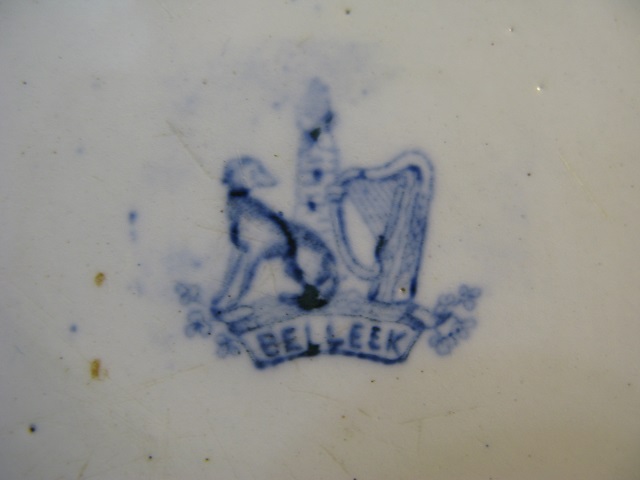
Although this Trivet no longer has its original
three porcelain feet,
it does have an Impressed Harp Mark
in
addition to
its unusual BLUE First Period Mark !!
Advancing, the following picture exhibits a fine
example of an
Earthenware (Soup) Plate !! Its
Pottery Scenic Transfer is an unusual
Green Colour !!
Above the bridge, Robert Williams Armstrong’s
residence
is partially visible !! Note also, the fine
Family Crest (Jewsbury Coat
of Arms) as well as the
black and orange borders !!
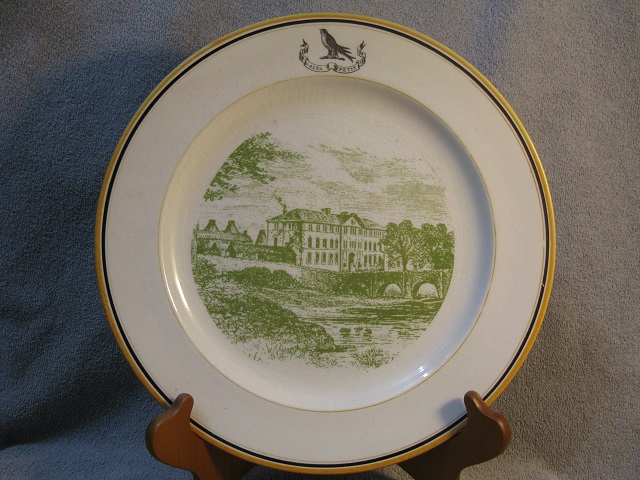
Note : NO fisherman on this one
!!
Displayed below, is the 1st Period Mark on this plate !!

In addition to this splendid
First Period Transfer Mark
this Plate also exhibits an Impressed
Harp and Crown Mark !!
Pièce De Résistance !! Saving the masterpiece for
last, I present this
SPLENDID example of a
Tridacna Tea Trivet as you see following !! Not
many of Belleek’s Tea Sets offer a Tea Trivet, but
IF one is available,
they are an extremely desirable
item as an accessory to your Tea Set !!
I don’t
purport a vast knowledge of individual Tea Ware
items, as I
have only a couple of representative
sets remaining in my collection,
but in addition to
Tridacna, the ONLY other Tea Sets, I can ‘think’
of
at the moment, which Belleek Produced a
Tea Trivet for were Grass and
Thorn !!?? If any
of you Belleeker enthusiasts out there are proud
owners of or know of other Pattern examples in
existence, I would be
more than pleased to hear
directly from you !! HOPEFULLY with
accompanying
photographs !! THANKS !!
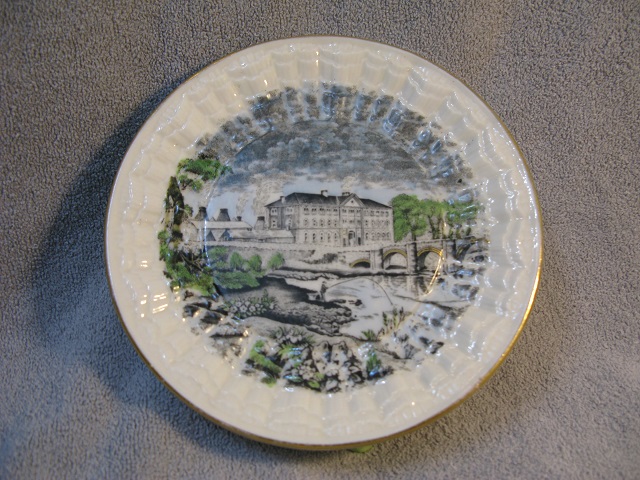
Note the finely detailed
painted decoration,
as well as the Gilt Trim on
the border and bridge arches !!
This example also includes a fisherman on the
Banks of the River Erne
!!
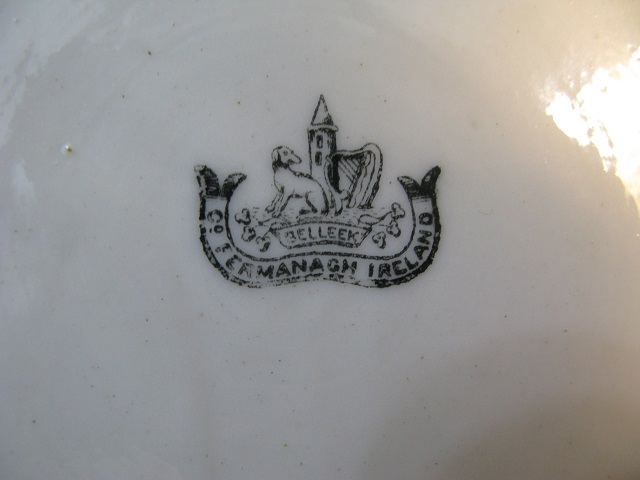
Our Tridacna Tea Trivet was Produced and Decorated
during Belleek’s 2nd Period !!
From a SPLENDID FaceBook Article, contributed by
our illustrious
Pottery author publishing under the
pseudonym ‘Robert Armstrong’, we
visualize a
beautiful example of our Belleek Pottery, hand
decorated on
a Hexagon Cup and Saucer, attributed
to Belleek Artist Ms Gertrude
Johnston !! You may
examine this article in its entirety at the
following
Link :
Hexagon Cup and Saucer !!
As seen from the above, this decoration was
completely hand painted
without the use of any
transfer ‘guide’ !! It remains an exquisite
example
of perseverance, skill and talent exhibited by some
of the
Pottery’s original decorators !! Personally, I
can’t paint by numbers,
so attempting to decorate a
curved surface, in addition to the fluted
lips of
something like a Hexagon Pattern Cup would be
tremendously
frustrating to my psyche !!
Briefly exiting our discussion regarding the
appearance of this
transfer on actual Pottery
items let’s shed some light on other
displays on
which Belleek exhibits their proud Pottery image !!
The
most obvious, would be the little advertisement
folder Belleek inserts
in each of their product boxes,
briefly outlining the Pottery’s History
and on
occasion, also including a tad bit of history of
the particular
item, especially in the case of
Limited Editions !!
Other forms of announcements have be published
throughout the Years,
mostly in the format of
event notices or invitations to special
meetings !!
What you envision following, is a tempting poster,
hopefully enticing the public to tour the Belleek
Pottery Premises !!
Unfortunately, I have no idea
as to the exact age of this placard nor
my
involvement in its acquisition ?? I do acknowledge
that it forms
part of my collection of three rather
sizable cartons of Belleek
literature, including
everything from pages extracted from magazines
to
brochures obtained from museums around
Ireland !! To present an awe of
antiquity, it is
printed on a firm yellowish/brown paper in a
brownish
lettering tone !!
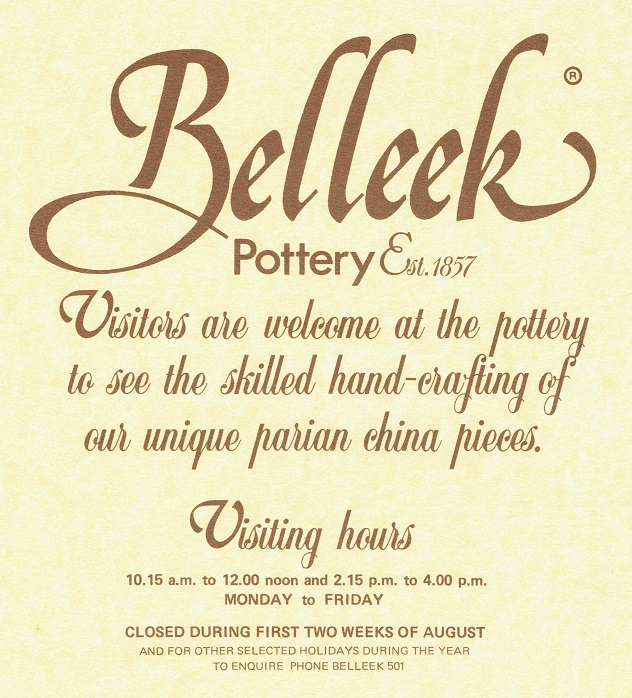
|
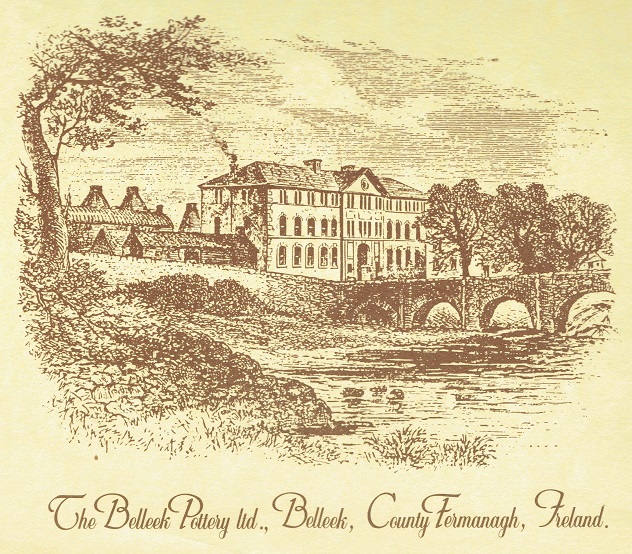
|
As I mentioned earlier, the public was also quite
enthusiastic and
enamoured over this powerful
structure !! They should have been, since
the
Pottery was probably responsible for at least half
the employment
of the area and possibly upwards of
one hundred percent accountable,
indirectly for the
remaining jobs in and around the town of Belleek !!

Above, we see an early postcard of our Belleek Pottery !!
As the process of colour photography was in its
infancy, even around
the turn of the 20th Century,
this postcard was inevitably the product
of a coloured
photograph !! As opposed to ‘true’ colour photography,
a
coloured photograph is simply a black and white
picture augmented,
primarily with pastel shades, to
provide the illusion of actual life !!
This process of
tinting would have been very similar to that of
painting the brilliant transfers the Pottery utilized
on some of their
wares especially the armorial
pieces !!

My beautiful Postcard hanging
in my entryway !!
Just prior to editorial release, I decided to include
the above picture
as I was extremely delighted and
satisfied with the results of the
framing job which,
I feel complement my Pottery postcard and adds an
aesthetic and creative conversational object on my
entry way wall !!
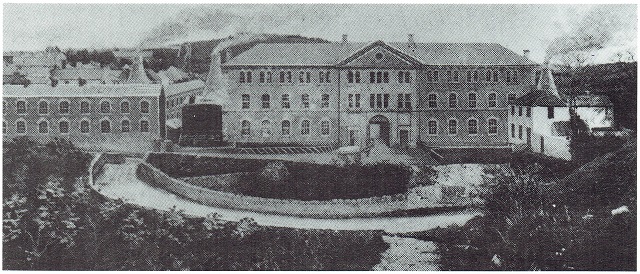
Compliments of Richard K. Degenhardt’s Belleek
The Complete Collector’s Guide and
Illustrated Reference
Second Edition, page 7 (© 1993)
There was a ‘force’ which, was disturbing me as I
published this night
after night ?? At first I felt it
was simply, what is referred to as,
the freedom of
artistic and poetic license !! Then it ultimately
impacted me with mind splitting energy !! If we
closely examine each of
the separate transfer
examples, you will notice to the left of the main
Pottery building, as you view each item, there are
three additional
extended single story buildings !!
Even on the hand painted Hexagon Cup
and Saucer,
she painted one extra structure !! Of interest to
these out
buildings is first, they are all constructed
as single floor industrial
expanses but more
important, is they LACK any windows !!
Now, please return to my postcard photograph as
well as Dick’s
published early Pottery picture !! My
postcard clearly displays again,
a single, windowless
structure !! Due to the actual perspective,
additional
structures surely can, and probably do, exist behind
the one
we can discern !! The essential clue here
though is windowless !! Now,
take another glance at
Dick’s reference and you will clearly identify a
TWO
level structure WITH windows !!
Thus, I now hypothesis our Pottery scenic transfer
was etched on its
copper plates extremely early in
the Pottery’s distinguished history,
as it displays,
what I suspect are simply temporary buildings !!
The ‘later’ photograph, from Dick’s work, would
then exhibit a completed
project, or one very near
realization !!
I believe this verifies the fact that our Pottery was
constructed
carefully over a period of Years and
during several of these periods,
buildings were razed
and improvements included ??!! It’s abundantly
possible that these side work places were utilized
for pottery
production while the final bricks were
being laid for the main building
!! These ‘temporary’
structures were then demolished in favour of their
permanent counterparts !! Unfortunately, we’ll
probably never realize
the ultimate veracity unless
we’re fortunate enough to unearth
antiquated
documents from some obscure local attic repository
which, if
fortune radiates her brilliance upon us,
we will again unravel another
Belleek mystery !!
I attempt to honour my habit of not ‘advertising’ in
any of my
Newslettres, but, with this topic, I’m
electing to make a slight
exception !! During the
Pottery’s 5th Period, a Celtic Commemorative
Plate
was produced which, included our Pottery Scenic
Transfer in its
center !! I display it below !!
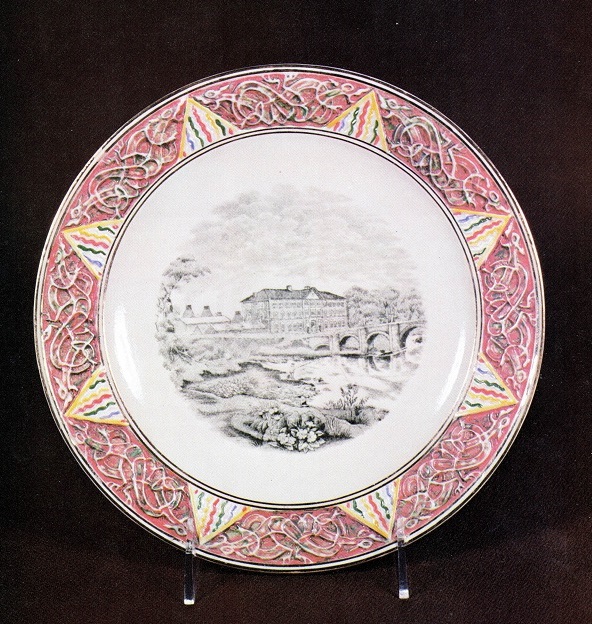
5th Period Celtic Scenic
Commemorative Plate !!
Unfortunately, since this is a ‘Scan’ of a picture, its
quality is
quite reduced and thus, the resulting object
appears rather inferior !! None the less, it’s another
beautiful example of the Pottery’s
production skills
and if any of you Belleekers out there know of one
for sale, I’d be more than interested !! THANKS !!
Now, furnished with this swathe of knowledge, are
you all prepared to
join us on an excursion to the
Belleek Pottery’s 160th Anniversary ??
**
SUBSCRIPTION
INFORMATION !!
For those of
you I've 'lost contact' with, if you
WERE receiving my Newslettre and have NOT
received
one in a
bit, it's MOST probably due to a
Change in YOUR E-mail
ID !! Post me, i.e., E-mail,
your current ID and I'll
get you back on my list !!
If you read my Newslettres regularly and DID NOT
receive an E-mail notification of this Newslettre,
PLEASE just drop me an E-mail and I’ll be sure to
get you BACK onto my Circulation list !! THANKS !!
Of course, if you’re NOT currently on my List and
would LIKE to be in on my Mailing List, ALL you need
do is to drop me a SHORT note indicating 'that you
would like automatic notification of new Newslettres' !!
And, BINGO,
I'll ADD you to my list and you'll begin
receiving upcoming Newslettre
notifications !!
Belleekingly,
Del E. Domke, Belleek Consultant
16142 N.E. 15th. Street
Bellevue, WA 98008-2711
U.S.A.
Telephone : 1 (425) 746-6363
Message : 1 (425) 746-6363
FAX : 1 (425) 746-6363
(Télè first !!)
E-mail : delyicious@comcast.net
Web-site : The
Beauty and Romance of Irish Belleek (or) :
http://delyicious.magix.net/public/index.html
 PREVIOUS
NEWS
PREVIOUS
NEWS
 PREVIOUS
NEWS
PREVIOUS
NEWS











